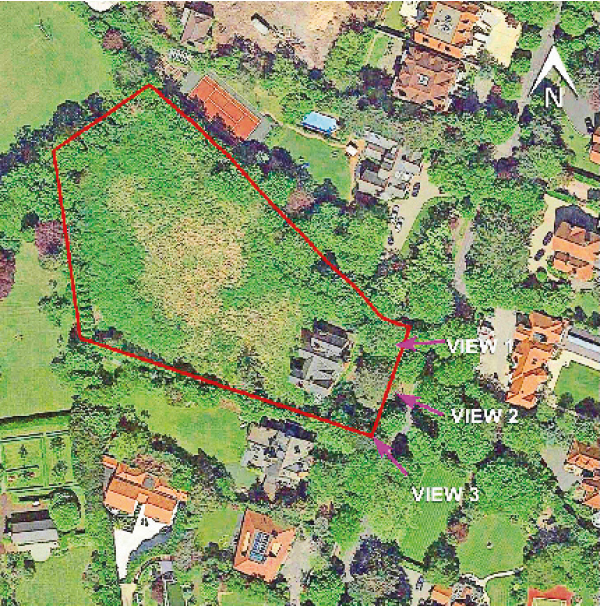
A satellite image of the the existing ‘Walford’ house on its vast 1.77 acre Shrewsbury Road site. From the Dublin City planning application.
By Alexander Kearney
In early September news rippled through the various property pages that a trust linked to billionaire Dermot Desmond had finally secured planning permission to demolish a large Edwardian house (with later additions) at No. 24, Shrewsbury Road.
The story attracted interest not simply because of the celebrity of the client, nor the seeming absurdity of demolishing a house its new owner had just paid €14.25 million for some eighteen months earlier, but because the property had once claimed the highest price for any private residence in the state: €58 million in July 2005.
The time and price call us back to the heady days of the Celtic Tiger. Certain locations, and Shrewsbury road is one of them, really do provide a ready index for the private excesses of that period, and ours. These are the places where the fruits of extreme wealth bloom and multiply, even when their owners are seldom at home.
In the business pages and the gossip columns, we can trace the rising fortunes and calamitous falls of past and current owners. Yet it is in the property pages and, perhaps more so, in the planning applications that even the very rich are obliged to submit, that we can see the physical character of ambition.
And here Dermot Desmond has succeeded where others have failed before. It has never been publicly confirmed who paid that stupefying €58 million for ‘Walford’, though it was widely reported that Gayle Killilea, who had married property developer Seán Dunne in 2004, claimed its ownership was transferred to her in 2005.
The property was subsequently transferred to a Cypriot company, Yesreb Holdings. The perceived value of the site was its location and size: an enormous 0.72 hectares (1.77 acres): a honeypot for development potential. After all, home, sweet home, it’s only a saying.
Yet on repeated occasions the planning authorities, including An Bord Pleanála, rejected applications to demolish or substantially modify the main house, and to add varying numbers of luxury houses (two applications sought an additional seven homes) to the sprawling back garden. Neighbours and planners clearly perceived the threat to Shrewsbury’s Road’s hushed and leafy character.
Desmond’s successful proposal had the signal advantage that he actually wanted to build a single family home, admittedly one that was a 17,168 sq ft mansion. To confirm that there really was a somebody behind the generic company name, ‘Celtic Trustees Ltd.’, the application stated, “in the interests of transparency, we can confirm that the dwelling is intended for use as the private dwelling of Mr Dermot Desmond.” The curtain of privacy was parted to secure a higher goal.
In the meantime, Mr Desmond’s assembled team had been busy at work to secure an objective crucial to their plans: the demolition of the existing house. On its face this was not an easy task, since the Council had blocked all previous attempts to demolish it, following the advice of their Conservation Department.
Mr Desmond’s appointed conservation architect, James Slattery, set about his task with grim efficiency, namely to dismantle the Council’s case for preserving the original 1902 house. (Here the writer should declare an interest, I have, in the recent past, appealed a planning application on which Mr Slattery served as consultant).
Slattery’s point-by-point rebuttal of the Conservation Department’s previous defence of ‘Walford’ – its “architectural quality” and “its considerable contribution to the rich and varied streetscape of Shrewsbury Rd. and its environs” – seem to have been effective. The fact that the house had been left unoccupied for many years also weighed in their deliberations.
As the Planner’s Report observed, “that given the dereliction of the site, the poor quality of the existing building in its architectural features, etc. and given the proposal for a single property which respects the existing character of the road, the demolition of the current property in this specific instance is considered to be acceptable.” When I passed by the house several weeks ago, five of its front windows had been left open, as if it had already given up the ghost.
Mr Desmond’s vision to replace the ramshackle and unloved ‘Walford’ derives from the late 19th / early 20th century symmetrical mansions of Britain’s last great classical architect, Sir Edwin Lutyens. It was a manner rarely practised in Ireland at that time, and rather at odds with the relaxed, vaguely neo-tudor houses that still characterise the street.
Lutyens practiced variations in that manner too, masterfully so, but given a clean sweep, Irish billionaires and their fortunes will tend to plumb for the symmetrical kind. If the generalisation seems too broad, consider that just down the road, a company acting on behalf of Denis O’Brien applied in 2007 to replace the already sprawling ‘Belmont’ house with another exercise in Lutyens’ classicism, this time exceeding 20,000 sq ft. That scheme was ultimately rejected, but the continued attraction towards this style invites consideration.
Enormous wealth has its own gravitational effect, especially when it is hard-earned rather than inherited. It draws its owners to certain ‘desirable’ locations, appears to dictate a borrowed dream of order, domination, and control, and then bends everyone in its field towards fulfilling its whim.
The sheer force of money is most discernible on those architects charged with giving the dream formal expression. In the cases of ‘Walford’ and ‘Belmont’, both sets of architects, have elsewhere been overwhelmingly modernist in sensibility. Yet here they must play classical with varying degrees of leaden competence and failure.
And the megalomania of the deep pockets is, of course, contagious. In describing their plans for ‘Walford’, the architects Lawrence and Long name their sources, starting with Lutyens and rising to a startling invocation of Blenheim Palace by Vanbrugh and Hawksmoor – the only non-royal residence in England to be named a ‘palace’. A sense of proportion is not convincingly regained by their admission that, “the scale of Blenheim is enormous’.
Nor can it be found in the prospect of the new ‘Walford’’s proposed elaborate formal garden, or its cavernous underground pool, games room, gym, cellar, security room, servants’ quarters off a sunken courtyard, and double-height entrance hall with minstrels’ gallery, preceded by a grand porch and entrance lobby.
From bell push to faucet, all comforts will be taken care of, but the ultimate luxury is surely control. And the floor plans express exactly that. Each room takes its place in a thoroughly centralised plan, something as far from the spirit of the original Shrewsbury houses as it’s possible to imagine.
While Desmond’s totalising scheme evidently succeeded with the planners where O’Brien’s had failed, each pursued a second-hand vision for his palatial pad. The risk is, that as more owners seek to transform their already ample houses with ever more outlandish mock-Edwardian extensions, or to demolish them altogether, Shrewsbury Road will increasingly resemble a victim of advanced cosmetic surgery: plumped, ageless, implausible.
Desmond’s mansion won’t even be the biggest on the road. That accolade currently goes to No.2, Shrewsbury Road, which has been expanded to over 20,000 sq ft, the grand prize that eluded O’Brien. The architects were once again Lawrence and Long, for whom this extension work might have served as a calling card to Desmond. Only now, instead of adding to a large old house, they must fabricate an entirely new-old house from scratch. Perhaps not quite the prize they had been looking for, but one they must have felt unable to refuse. To date, the plans for Desmond’s palace have not appeared on the architects’ website.
As for its wealthiest and destined-to-be occasional residents, they might mull over the precipitous falls of some previous owners. Last April, the bankrupt property tycoon, Seán Dunne, told the High Court he, “didn’t need furniture to live in a house.” and, “If I lived in Windsor Castle does that mean I have access to the queen’s money?” Mr Dunne was pleading the kind of poverty that can only befall the very rich – consigned to large rooms with missing furnishings. As the song would have it, ‘in every dream home, a heartache’.



